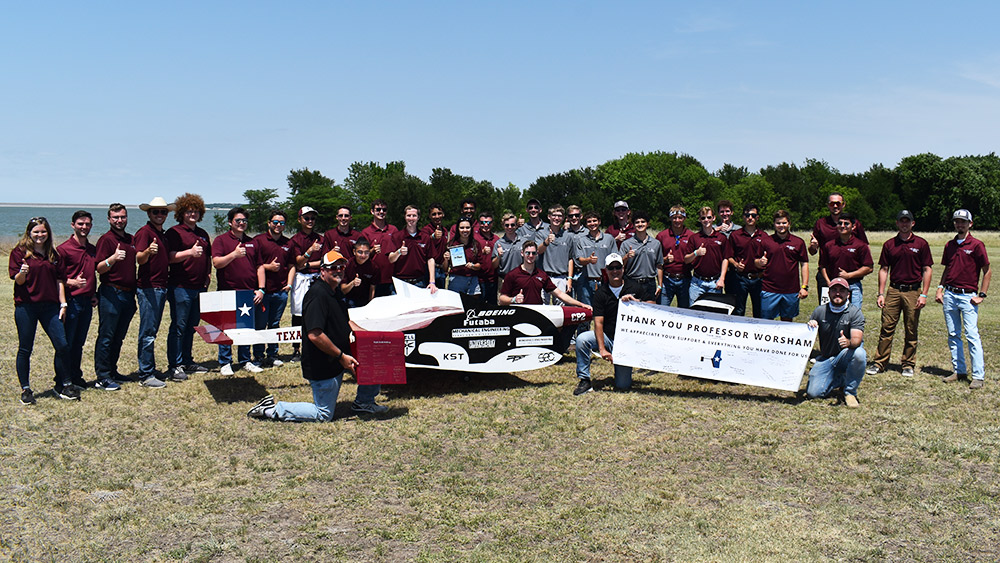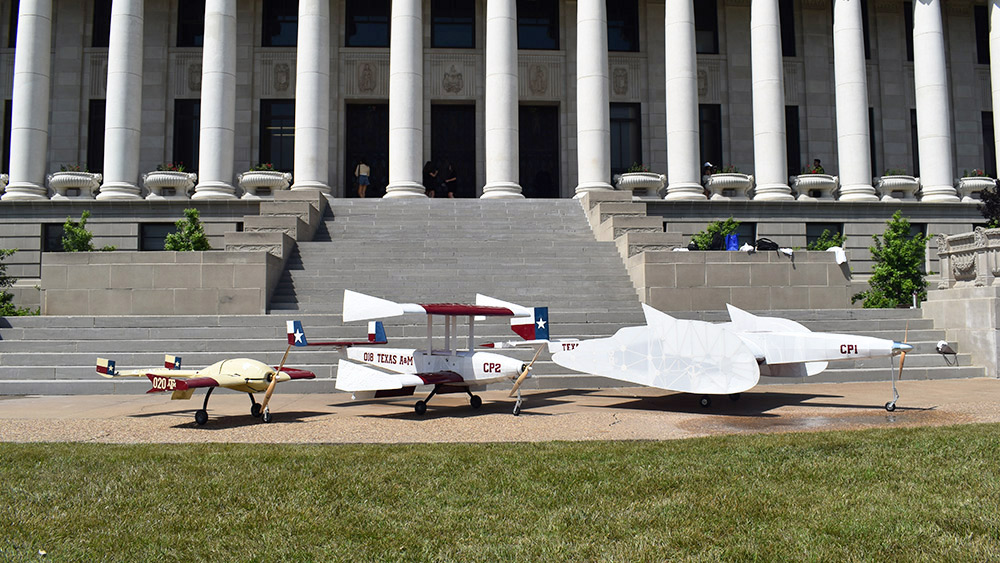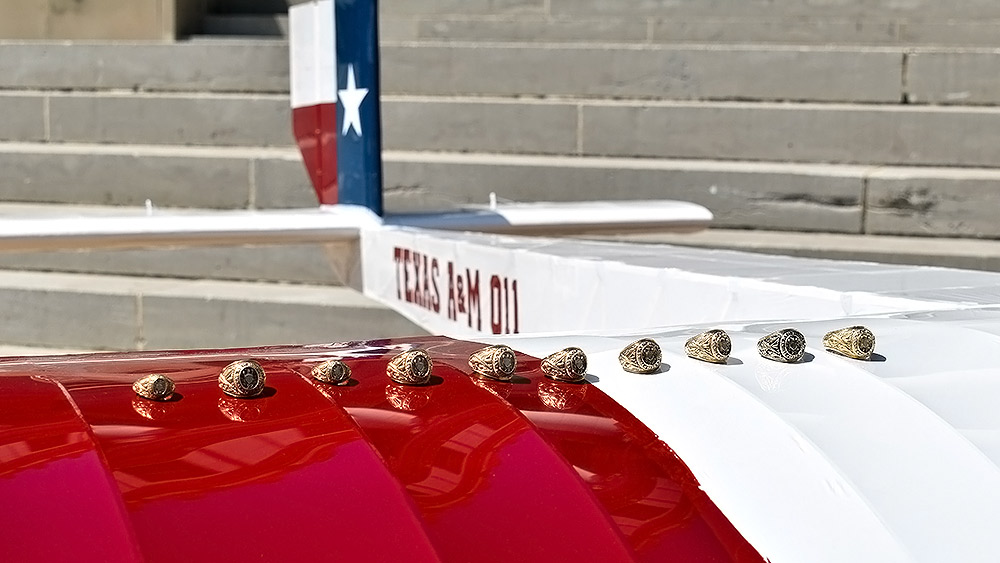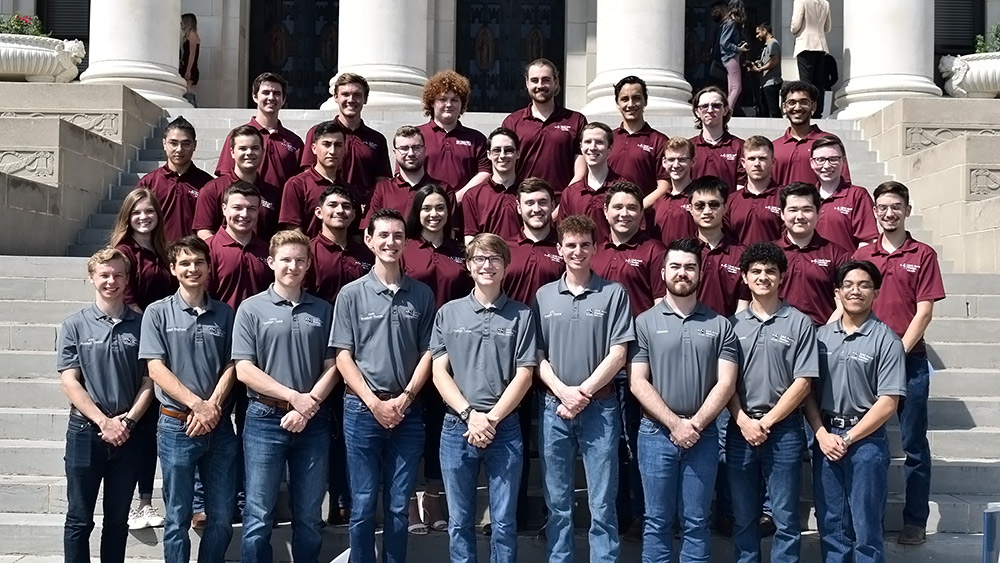
Texas A&M University’s Society of Automotive Engineers (SAE) Aero Design team has won first place for the third consecutive year in the Regular Class at the SAE Aero Design East competition. They also took a second team to compete in the Micro Class, bringing home fourth place. This is the first time since the 2010s that Texas A&M has competed in two classes.
SAE Aero Design is a competition that challenges students to design, build and fly a radio-controlled airplane optimized to meet specific configurations and mission requirements. The experience exposes students to real-world engineering situations and builds on their classroom knowledge, better preparing them for their future careers. The competition also allows students to practice their communication skills with a design report and technical presentation.
Farmers Flight
This year, the objective for the Regular Class was to design an aircraft that could take off within 100 feet while carrying a payload of steel and soccer balls. Knowing that the soccer balls had a higher point value, Texas A&M’s team, Farmers Flight, began experimenting with a design to place them in the wing of their aircraft.
“Each team takes a completely different approach to maximizing their flight score,” said Isabel Short, an aerospace engineering student and team member. “We were one of two or three teams that had the idea to put a soccer ball in a wing, and our plane had the capability to hold 26.”

It was an ambitious design, and their 14-foot-long aircraft with a 7-foot wingspan raised eyebrows at the competition. Once they hit the runway, though, Farmers Flight cemented their first-place win by carrying a total of 120 soccer balls over three flights, with the second-place team carrying a total of 24.
“We were writing on the back of napkins at last year’s competition, already messing around with designs,” said Josue Corleto, an aerospace engineering student and team director. “We had a lot of historical knowledge to play off of, we understood the rule set well, and we were confident that we had the skills and the ability to create such a different design.”
A total of 22 teams from around the world competed in the Regular Class, and Farmers Flight pulled away with first place overall and first place in mission performance.
Farmers Flight Lite
Interest in Texas A&M’s SAE Aero Design team has grown with their success over the last few years, which has created more opportunities for students to be involved. This year, they formed a second team, Farmers Flight Lite, to compete in the Micro Class.
The objective for the Micro Class was to take off from an 8-foot table and travel 300 feet while carrying as much payload as possible in steel and pizza boxes. In the past, teams at the competition have struggled to take off from the table, so Farmers Flight Lite put emphasis on a lightweight wing area and chose to go with a biplane design.
“We were a first-year team, so the fact that we were able to get off the table multiple times successfully at competition is an achievement in and of itself,” said Jeremy Ringwood, a mechanical engineering student and team member.
Even being a young team and experiencing build and competition for the first time, they found success in their design and pushed for the podium to the very end, only being short by about five points in flight.
“There’s almost a sense that no matter what happens, you’re proud because you harken back to the idea that you’ve done all this work and that work isn’t for nothing,” said Ewan Gill, an aerospace engineering student and team director.
Farmers Flight Lite competed against 19 other teams from around the world and placed fourth overall and fourth in mission performance.
Beyond competition
While the competition itself is a rewarding opportunity for the students, it’s the trial-and-error and coming together as a team that has had the biggest impact.

“I’ve never seen a team come together in the way that we did, and other teams were coming up to us at competition and talking about how our team seems so close,” said Short. “Just seeing everything that we had done throughout the year come together was special.”
SAE gives students a unique introduction to the real world as they’re able to take the theoretical knowledge they learn in the classroom and apply it to the whole design process of prototyping, testing, validation and verification.
“You’re never going to get anything as close to putting a plane that you designed on the flightline and trusting that it’s going to work,” said Ringwood. “And the experience gives you great things to talk about in interviews and put on your resume.”
Preparing students for their future when they leave SAE and Texas A&M is the reason the team’s advisors commit so much of their time to support them throughout the year. Brad Worsham and Scott McHarg, both from the aerospace engineering department, have advised Texas A&M’s team for the last few years, and the students have found an invaluable resource in them.
“They’re just great people, they’re awesome to work with, and our team as a whole would not be where it is without them,” said Gill. “Brad has been teaching at Texas A&M because that’s what he wanted to do. He wanted to teach and see people go through this process of becoming better engineers.”
The advisors invested many weekends and hours after work helping the students test their designs and learn from practice flights.
“Scott, our pilot, puts in hours with us behind the scenes at RELLIS before competition,” said Corleto. “As soon as it takes off, you know that it’s in good hands. Even with some of the worst planes that we’ve thrown at him, he figures them out, which still allows us to get feedback and information from our designs.”
The students plan to compete in both the regular and micro classes again at next year’s competition, with Short directing the Regular Class and Ringwood directing the Micro Class.
Learn more about Texas A&M’s SAE Aero Design team and the annual SAE Aero Design competition.
